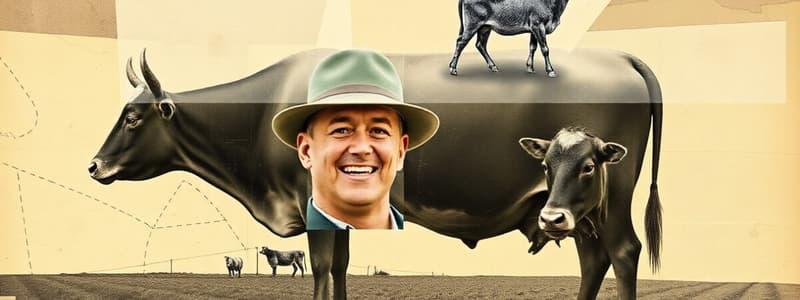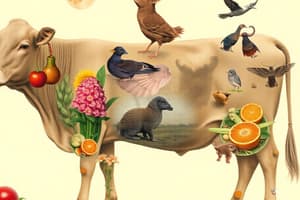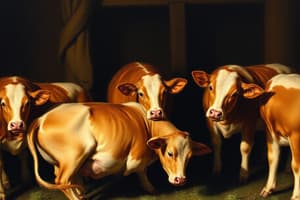Podcast
Questions and Answers
Explain why energy is often considered the most important nutrient for livestock.
Explain why energy is often considered the most important nutrient for livestock.
Energy is required for basal metabolism, activity, maintaining body temperature, growth, reproduction, and production.
How does protein quality, specifically the amino acid profile, influence the nutritional value of a feed for livestock?
How does protein quality, specifically the amino acid profile, influence the nutritional value of a feed for livestock?
Protein quality determines the availability of essential amino acids, which are necessary for tissue building, enzyme production, and overall growth, because they cannot be synthesized by the animal itself.
Describe the role of macro-minerals and micro-minerals in livestock nutrition. Provide one example of each and their primary function.
Describe the role of macro-minerals and micro-minerals in livestock nutrition. Provide one example of each and their primary function.
Macro-minerals are needed in larger quantities and are vital for structural components and fluid balance (e.g., calcium for bone formation). Micro-minerals, or trace minerals, are required in small amounts for enzyme activation and immune function (e.g., zinc for enzyme activation).
Explain the difference between fat-soluble and water-soluble vitamins and provide an example of each, noting their importance in livestock.
Explain the difference between fat-soluble and water-soluble vitamins and provide an example of each, noting their importance in livestock.
Summarize the key functions of water in livestock and how inadequate water intake impacts their health and productivity.
Summarize the key functions of water in livestock and how inadequate water intake impacts their health and productivity.
How do the nutrient requirements of young, growing animals differ from those of mature animals, and why?
How do the nutrient requirements of young, growing animals differ from those of mature animals, and why?
Describe how environmental temperature affects the energy requirements of livestock and explain the physiological reasons behind this.
Describe how environmental temperature affects the energy requirements of livestock and explain the physiological reasons behind this.
Explain how rumen microbes contribute to meeting the protein and vitamin requirements of ruminant animals.
Explain how rumen microbes contribute to meeting the protein and vitamin requirements of ruminant animals.
Why is feed analysis important in livestock nutrition? How does it contribute to effective ration formulation?
Why is feed analysis important in livestock nutrition? How does it contribute to effective ration formulation?
Describe how feed additives like enzymes, probiotics, and prebiotics can improve nutrient utilization in livestock.
Describe how feed additives like enzymes, probiotics, and prebiotics can improve nutrient utilization in livestock.
Flashcards
Energy Requirements
Energy Requirements
Expressed as Digestible Energy (DE), Metabolizable Energy (ME), or Net Energy (NE).
Protein Importance
Protein Importance
Building and repairing tissues, producing enzymes, hormones, and antibodies; quality depends on amino acid profile.
Mineral Role
Mineral Role
Inorganic substances for bone formation, enzyme activation, and electrolyte balance.
Vitamin Function
Vitamin Function
Signup and view all the flashcards
Water's Role
Water's Role
Signup and view all the flashcards
Species Impact
Species Impact
Signup and view all the flashcards
Feed Analysis
Feed Analysis
Signup and view all the flashcards
Ration Formulation
Ration Formulation
Signup and view all the flashcards
Monitoring Health
Monitoring Health
Signup and view all the flashcards
Proper Storage
Proper Storage
Signup and view all the flashcards
Study Notes
- Nutrient requirements for livestock are essential to optimize their health, productivity, and overall well-being.
- These requirements vary based on species, age, physiological state (growth, pregnancy, lactation), and production level.
- Key nutrients include energy, protein, minerals, vitamins, and water.
- Requirements are typically expressed as concentrations within a feed or as a daily intake.
Energy Requirements
- Energy is the most important nutrient because it is required for maintenance, growth, reproduction, and production.
- Energy requirements are typically expressed as Digestible Energy (DE), Metabolizable Energy (ME), or Net Energy (NE).
- Maintenance energy requirements cover basal metabolism, activity, and maintaining body temperature.
- Growing animals require additional energy for tissue deposition.
- Pregnant and lactating animals have increased energy needs to support fetal development and milk production.
- Production animals, such as those raised for meat or fiber, require energy for muscle growth or wool production.
- Factors affecting energy requirements include body weight, breed, environmental temperature, and activity level.
- Carbohydrates (from grains and forages) and fats are the primary energy sources in livestock diets.
Protein Requirements
- Protein is crucial for building and repairing tissues, as well as for producing enzymes, hormones, and antibodies.
- Protein quality is determined by the amino acid profile, particularly the presence of essential amino acids.
- Essential amino acids cannot be synthesized by the animal and must be supplied in the diet.
- Examples of essential amino acids include lysine, methionine, tryptophan, and threonine.
- Protein requirements are influenced by age, growth rate, pregnancy, and lactation.
- Young, growing animals have higher protein requirements compared to mature animals.
- Protein requirements can be met through various feed sources, including soybean meal, fish meal, and alfalfa.
- Excess protein can be converted to energy or excreted, placing additional burden on the animal's kidneys.
- Ruminant animals can utilize non-protein nitrogen sources, such as urea, which rumen microbes convert into microbial protein.
Mineral Requirements
- Minerals are inorganic substances required for various physiological functions, including bone formation, enzyme activation, and maintaining electrolyte balance.
- Macro-minerals include calcium, phosphorus, magnesium, potassium, sodium, chlorine, and sulfur.
- Micro-minerals (trace minerals) include iron, zinc, copper, manganese, iodine, selenium, and cobalt.
- Calcium and phosphorus are critical for bone development and milk production.
- Magnesium is involved in enzyme systems and nerve function.
- Potassium, sodium, and chlorine are essential electrolytes that regulate fluid balance.
- Sulfur is a component of certain amino acids and vitamins.
- Iron is required for hemoglobin synthesis and oxygen transport.
- Zinc, copper, and manganese are involved in enzyme activation and immune function.
- Iodine is necessary for thyroid hormone synthesis.
- Selenium functions as an antioxidant and is important for immune function.
- Cobalt is a component of vitamin B12, which is synthesized by rumen microbes.
- Mineral deficiencies can lead to various health problems, such as rickets (calcium/phosphorus deficiency) and anemia (iron deficiency).
- Mineral requirements can be met through feedstuffs or mineral supplements.
Vitamin Requirements
- Vitamins are organic compounds needed in small amounts for various metabolic processes.
- Fat-soluble vitamins include A, D, E, and K.
- Water-soluble vitamins include B vitamins (thiamin, riboflavin, niacin, pantothenic acid, pyridoxine, biotin, folic acid, and cobalamin) and vitamin C.
- Vitamin A is important for vision, immune function, and epithelial cell maintenance.
- Vitamin D is essential for calcium absorption and bone metabolism.
- Vitamin E functions as an antioxidant and is important for immune function and muscle health.
- Vitamin K is required for blood clotting.
- B vitamins are involved in energy metabolism and enzyme function.
- Vitamin C (ascorbic acid) is synthesized by most livestock species, but may be required in the diet of some animals under stress.
- Vitamin deficiencies can result in a variety of health problems, such as night blindness (vitamin A deficiency) and rickets (vitamin D deficiency.)
- Vitamin requirements can be met through feedstuffs or vitamin supplements.
- Ruminant animals can synthesize some B vitamins in the rumen.
Water Requirements
- Water is the most critical nutrient, as it is involved in virtually every physiological process.
- Water functions as a solvent, transport medium, temperature regulator, and lubricant.
- Water requirements vary depending on species, age, physiological state, environmental temperature, and activity level.
- Water intake can occur through drinking water, feed moisture, and metabolic water production.
- Inadequate water intake can lead to dehydration, reduced feed intake, and decreased productivity.
- Water quality is important, as contaminated water can transmit diseases and toxins.
Factors Affecting Nutrient Requirements
- Species: Different livestock species have different digestive systems and metabolic rates, resulting in varying nutrient requirements.
- Age: Young, growing animals have higher nutrient requirements per unit of body weight compared to mature animals.
- Physiological state: Pregnancy, lactation, and growth increase nutrient requirements.
- Production level: Animals with high levels of production (e.g., milk yield or growth rate) require more nutrients.
- Environment: Environmental temperature can affect energy requirements.
- Breed: Different breeds within a species can have different nutrient requirements.
- Health status: Sick or stressed animals may have altered nutrient requirements.
Practical Considerations
- Accurate feed analysis is essential to determine the nutrient content of feedstuffs.
- Ration formulation involves balancing nutrient requirements with the nutrient content of available feedstuffs.
- Feed additives, such as enzymes, probiotics, and prebiotics, can improve nutrient utilization.
- Regular monitoring of animal health and performance is important to ensure that nutrient requirements are being met.
- Nutritional programs should be tailored to meet the specific needs of the animals and the production goals of the farm.
- Proper feed storage and handling are essential to maintain feed quality and prevent nutrient losses.
Studying That Suits You
Use AI to generate personalized quizzes and flashcards to suit your learning preferences.




